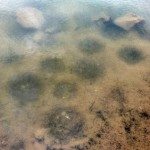If you’ve followed either of the last 2 FLW Cup tourneys, then you’re aware that the bluegill bed bite played a role in many of the top finishers game plans for both events. Seems like it would make sense then to know a little bit about bluegill nesting behavior. Some interesting research concerning UV radiation and bluegill nesting depth provide some “food for thought”.
The study took place on Lake Giles, a lake with very good water clarity, often in the 26-32′ range. As such, the general patterns of behavior should remain similar, but the depths might be quite a bit shallower if you’re bassin’ lake isn’t gin clear.
- At the start of the spawning season, the majority of all bluegill nests were located in the first 5 feet of water. This was largely attributed to water temp. The earliest wave of spawners were largely restricted to the warmth of the shallows, and subsequently exposed to the most UV radiation.
- The next wave of spawners two weeks later spawned around the 13′-15′ range with about 75% of the entire group spawning between 10′-15′. Warmer water let fish spawn in deeper water and further from UV penetration.
- The final group of spawners split depths (bimodal) with about half going shallow and half going deep.
- Water temps remained fairly stable and consistent in the first 10 feet of depth regardless of spawning wave, temps were just warmer overall as the season progressed over the 4 week period.
- Approx. 90% of all irradiance (light attenuation at 320 nm – longer wave UVA) was absorbed in the first 5 feet of depth. Early in the season (1st spawning wave) the 1% attenuation depth was approximately 8 feet. The later weeks (2nd and 3rd waves) had 1% attenuation levels of about 5 feet. In other words, UV couldn’t penetrate as deep into the water later since more of it was absorbed in the surface layers.
How else does this fit into the bass fishing equation? Start thinking in terms of black lights and fluorescent monofilaments (the line only ‘glows’ so far into the water), phyto- and zooplankton avoidance as relates to shad (shad feed on planktons and planktons tend to try and avoid high UV), water temperatures at depth due to sun “warming” (a big cause of thermocline formation in lakes), the bluegill bed bite (where and how deep to look depending on how late in the year), etc. There are a lot of scenarios and potential behavioral/physical explanations and applications.

























